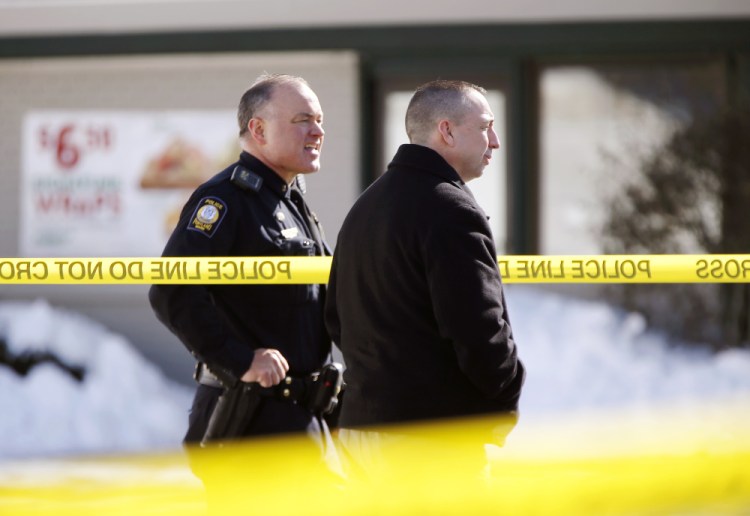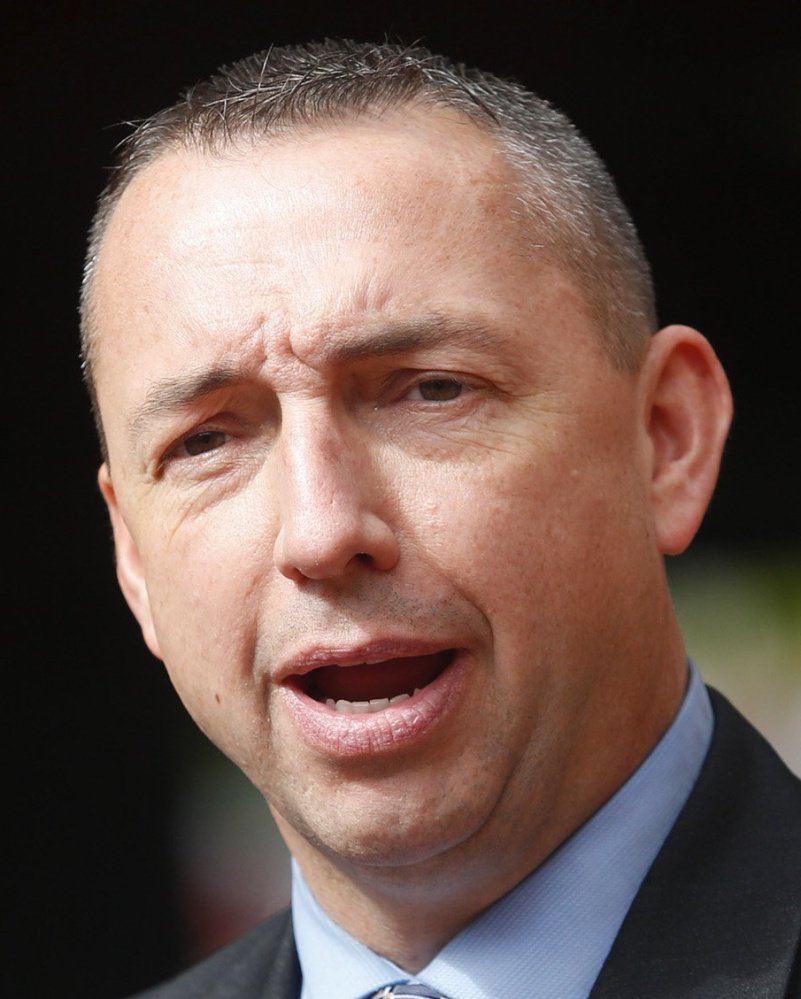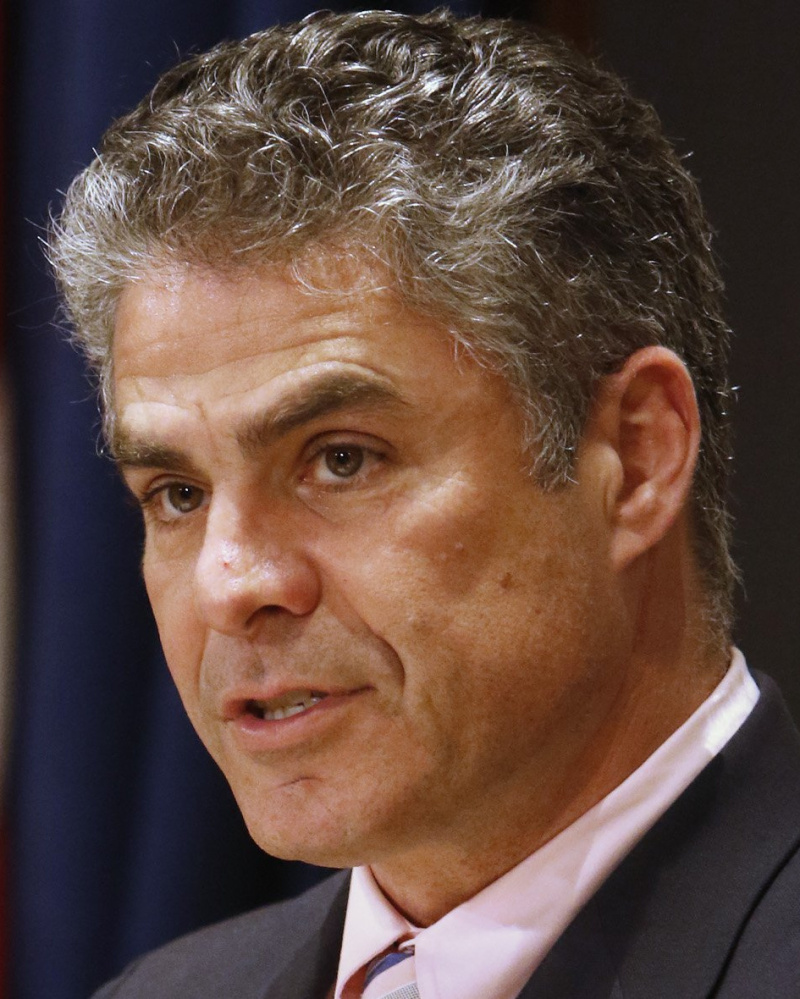Portland Police Chief Michael Sauschuck is disgusted by what he says is the mayor’s politicizing of the fatal police-involved shooting of a 22-year-old man by a veteran officer on Saturday.
On Monday, Mayor Ethan Strimling said that a plan to roll out cameras on the Portland force should be accelerated, and that in general and in this specific instance, footage from the body-worn devices would be helpful to investigators examining the aftermath of such confrontations. The American Civil Liberties Union of Maine, the Portland chapter of the NAACP and Progressive Portland also urged the city to speed up its plans for the cameras.
“There have been individuals and organizations that seem to have used this particular incident as a platform to further an agenda,” Sauschuck said. “I don’t appreciate that and I don’t think it’s necessary in this community to drag the Portland Police Department into some sort of national debate about body cameras.”
When asked if he was referring to the mayor, Sauschuck acknowledged that he was.
Chance David Baker was shot and killed after police said he refused to comply with their commands to put down a weapon. The officer who shot Baker – Sgt. Nicholas Goodman – is on administrative leave pending an investigation by the Attorney General’s Office, which is standard protocol.
Sauschuck, during a news conference Tuesday afternoon, responded forcefully to those suggestions.
“I am saddened, I’m disappointed, and I’ll tell you I’m disgusted by any use of a tragedy to further some kind of political agenda around body cameras,” he said.
The chief said Goodman was 100 feet away when he shot Baker with a rifle from a protected position behind a police cruiser – details not previously released to the public.
“I’m not sure what a body camera does for the situation from 100 feet away, which to me, lends it to believe that this has some kind of political overtones, trying to further a message about body cameras,” Sauschuck said. “Tragedies are not the time to do that. Somebody lost their life in our community and we give our condolences to the entire Baker family.”
However, Strimling, who learned about the shooting from City Manager Jon Jennings, said he didn’t know that Baker was shot from 100 feet away when he advocated for expediting the use of body cameras by city police.
Sauschuck said that after decades of using cruiser-mounted dash cameras, in 99.9 percent of cases, the footage backs up an officer’s version of events, and that in this instance, he believes his officers’ account.
“I take umbrage to anybody that would feel that we somehow need a camera to tell us exactly what happened,” Sauschuck said. “Sgt. Nick Goodman told me what happened and other police officers told me what happened, and to me, their word is a bond.”
Baker bought a rifle-style pellet gun from Coastal Trading & Pawn in the Union Station Plaza on St. John Street and then wielded it in a threatening manner outside a Subway restaurant nearby, police said.
Witnesses called police about 11:10 a.m. Saturday, police said, when they saw Baker pointing the rifle at passing cars in the shopping center parking lot and shouting obscenities. Officers responded and witnesses reported that Baker was shot in the forehead.
When police make the decision to use deadly force they are trained to shoot to kill.
Goodman, a 14-year veteran, has been involved in a deadly force incident before. In 2008, he shot and killed a 48-year-old Portland man, which was ruled to be a justifiable homicide by the Attorney General’s Office.
Sauschuck said Tuesday that although cameras are expected to become standard for police in the coming years, implementing them takes time and requires careful consideration.
He also cautioned that they are not a magical solution.
“I think there’s a lot of value to body cameras. I also think they’re not the panacea that the general public would think that they are, that they will give you every answer to every question (in) every situation.”
More than just the equipment that police would wear, adopting body-worn cameras means drafting a policy about when the devices should be turned off and turned on, who should have the right to review the footage, how long footage is stored, and a myriad of other privacy and ethical concerns.
The national focus on body cameras arose after the Aug. 9, 2014, killing of Michael Brown, a black teenager in Ferguson, Missouri. Brown was shot by a white policeman who was later cleared of wrongdoing in the case. Intense scrutiny of the course of events, and early, sometimes contradictory information about how the shooting unfolded, led to widespread calls for more cameras and more transparency.
Now, federally funded research is underway to examine the cameras’ overall effect on law enforcement and community relations, and in 2015, the U.S. Justice Department offered $20 million in grants for departments to adopt the equipment and develop policies on their use.
South Portland police recently started using the cameras and initially drew criticism from civil liberties groups for not releasing their policies around the use of the technology.
Strimling’s comments Monday were directed at accelerating plans already underway to bring cameras to the Portland department, including spending city money to start a pilot program.
At a finance committee meeting two days before the shooting, Strimling urged city councilors to spend city money to implement a trial program sooner.
“Making this commitment now, as opposed to a year from now, ensures the community knows we are serious and will also allow us time to test the equipment and make necessary adjustments,” he wrote at the time.
The city had earmarked $400,000 in fiscal 2019 to invest in the equipment, and during the news conference Tuesday, Sauschuck said the department is researching camera policies from police associations and other departments that are using the devices, and is pursuing grant money to start a pilot program in the city.
In a brief statement Tuesday evening Strimling stood by his position, reasserting his belief that the city should move more quickly.
“I have great respect for the chief, but on this we disagree,” Strimling said. “I have advocated for body cameras because it is good policy that injects a higher level of transparency into our policing and builds trust in the community. I know emotions are high right now, but I look forward to working with the chief, the council and the community to bring this vital technology to our city.”
Rachel Talbot Ross, president of the Portland chapter of the NAACP, also released a statement disagreeing with the chief’s assertion about political motives.
“To suggest that our advocacy for body cameras at this time was in the service of a political agenda is troubling and extremely divisive,” the statement said.
“We have consistently supported the use of this technology because it is not only good policy, but has proven to provide the public with a greater sense of trust and transparency in their local law enforcement.”
Progressive Portland also reaffirmed its position that body cameras should be included in this year’s budget.
“This is not political,” the group said in a statement. “It’s good policy. We encourage Chief Sauschuck to join us in supporting this common sense reform.”
Matt Byrne can be contacted at 791-6303 or at:
Send questions/comments to the editors.






Success. Please wait for the page to reload. If the page does not reload within 5 seconds, please refresh the page.
Enter your email and password to access comments.
Hi, to comment on stories you must . This profile is in addition to your subscription and website login.
Already have a commenting profile? .
Invalid username/password.
Please check your email to confirm and complete your registration.
Only subscribers are eligible to post comments. Please subscribe or login first for digital access. Here’s why.
Use the form below to reset your password. When you've submitted your account email, we will send an email with a reset code.